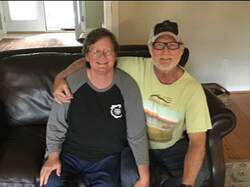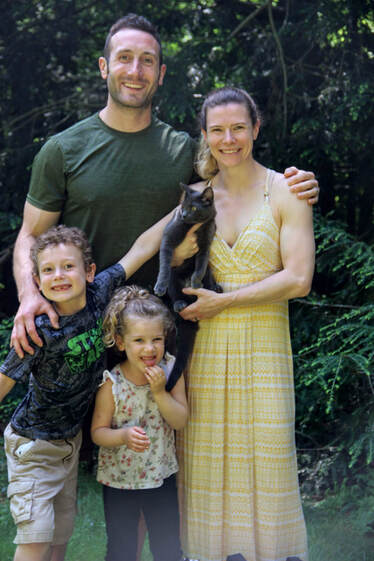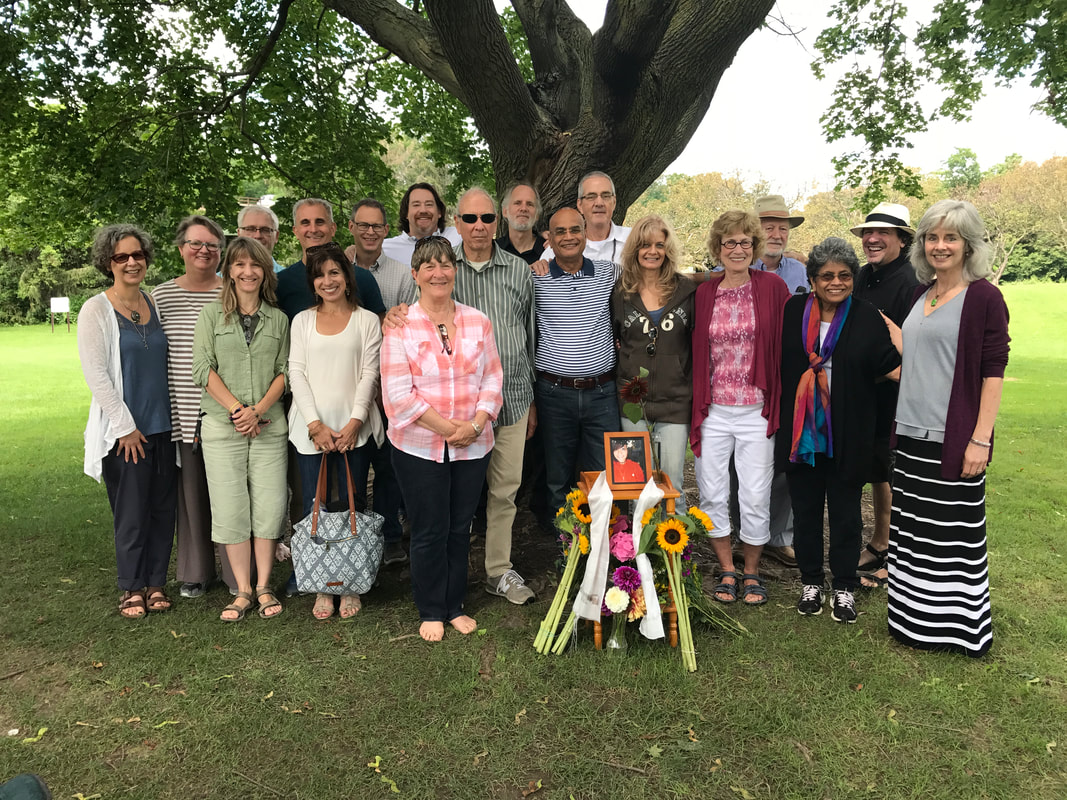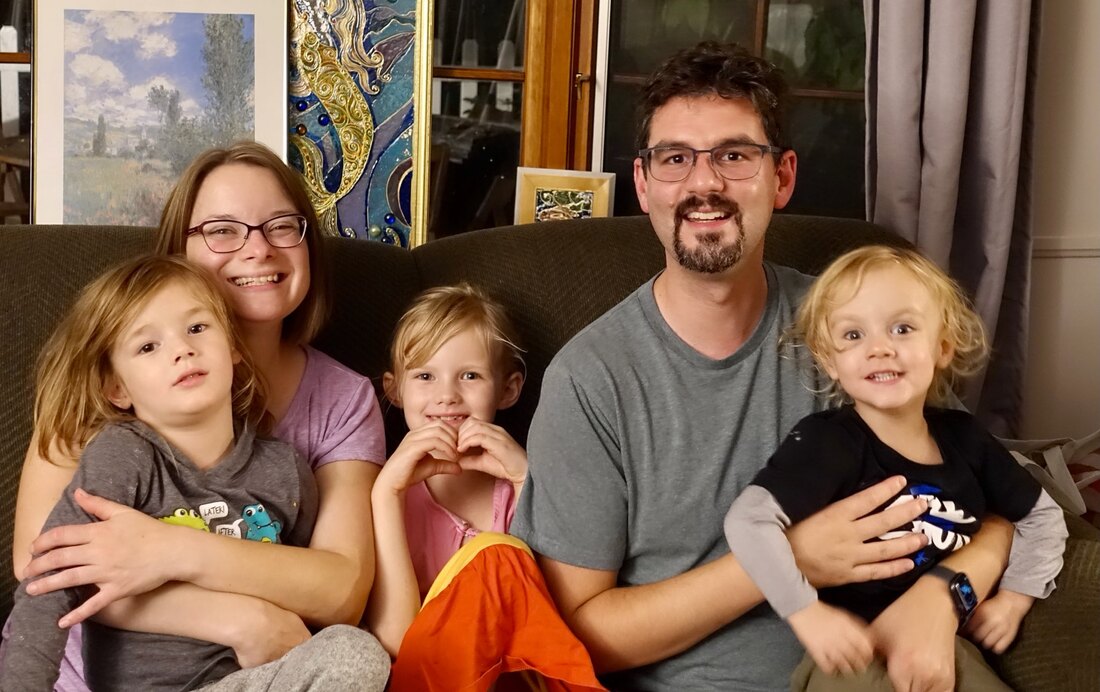Member Stories
For one of our Fall Membership Initiatives, several Dharma Refuge members interviewed other members about why they are part of our sangha and how this has affected them. We want to share what we heard. We hope you enjoy reading these stories.
Samantha Lynch and Gary Updyke: Our Poison is Also our Medicine

Interview and Article by Dennis Mnuskin
"Hi, my name is Dennis. I’ve been a volunteer at Dharma Refuge since 2018, helping with memberships, and more recently I’ve joined our Board of Directors as well as a new Membership Committee whose primary aim is to promote stronger relationships within our sangha. We are considering quite a few ideas and this article is a direct result of that exploration. What if we were to ask some of the members if they would like to share their own story with the rest of our sangha? So we did. And they said yes."
|
Recently I had a conversation with Gary Updyke and his daughter, Samantha Lynch. It was especially exciting for me to do this because when I first joined Dharma Refuge in March of 2017, the first two people I met were Gary Updyke and Brian Edelbach, who both gave me an incredibly warm welcome. In part because of Gary and Brian, I’ve come back almost every week. I’ve had a few previous chats with Gary and Sam, yet sitting down with them for this interview I’ve learned so much more.
Gary joined Dharma Refuge about 7 or 8 years ago. He had been meditating for years and had had teachers in the past, but one day Gary decided that “he had to get serious” or just stop doing it. Having Googled “mindfulness meditation instruction,” he found the Dharma Refuge website, showed up one night, and has been coming back ever since. For Gary, it was the warm reception from the community, being able to meditate with other people and, as he got to know Sue, realizing that she is his Teacher. Sam joined us in 2016 at the urging of her cardiologist, who said she absolutely HAD to join a meditation group. She was undergoing serious health issues that could have resulted in either death or amputation of both legs. She knew her dad was part of a meditation group but she didn’t know which one. Not even aware of it, she followed his footsteps, went on Google, and from there ended up in the same room as him. When Sam first joined us, she described herself as a die-hard atheist. She enjoyed the meditations but found herself getting up to leave, unable to handle the teachings. As time went on, Sam realized that what Sue, as well as the other teachers - like Anam Thubten, Garchen Rinpoche, and Elizabeth Mattis Namgyel - were talking about was relevant to her own life. The teachings and the community support were actually helping her heal. Sam especially recalls one night when the doctors were seriously talking about an amputation. She sat down after meditation practice with Sue, Marsha, Kathryn, and Sabrina (and possibly someone else, whose name escaped Sam when we |
spoke). They made room for Sam’s grief and everything she was going through. Sam described that as a pivotal moment in her life, and she attributes the women who were with her, Dharma Refuge, and Buddha’s teachings for saving her life.
For Sam, 2016-17 were brutal years, but the worst is now behind her. Her legs are safe, however she will have chronic health issues and pain for the rest of her life. Mindfulness and meditation practices have been significant in helping Sam manage that. For Gary and Sam, a few things from dharma teachings especially stand out. The first is this sense of connection and oneness with everyone else. We are all humans, we are all from the same source, all part of this same universe. And none of us are separate from anyone else, as sometimes we let ourselves believe. What every human being says and does has impact on themselves as well as everyone and everything around them. And in turn what happens around that human being will impact them. At the same time, we all make mistakes and sometimes do or say things that result in a negative impact. But we meditate, we reflect, and we learn to be patient with ourselves and others. We learn to forgive, to stay open, to do our best, and keep moving. We also discovered that all three of us were greatly affected by Pema Chödrön’s books and her teachings on the 37 Practices of the Bodhisattva that we studied as a sangha a few years back. Pema often talks about how "poison" is also our medicine: obstacle is the way. Everything in life --the good, the bad and the ugly -- all these things are teaching us something, if we learn how to pay attention to them. Being part of our sangha and listening to Sue and the other teachers has been incredibly helpful for both Sam and Gary in learning how to pay attention. We kept our conversation short as Sam was in the middle of a home remodel. She just bought her very first house and she had to get back to all those fun activities that first-time homeowners enjoy. In closing, both Gary and Sam send their love to everyone in the sangha... to the many people whom they haven’t seen in a long time. |
Ian Kleckner: Meditating is Like Learning to Ride a Unicycle
Interview and Article by Eric Manzler
|
Ian Kleckner and his family
At the end of 2018 Ian Kleckner was dealing with some family conflicts that were too stressful to handle using his existing coping tools. He sought counseling and the therapist he was seeing recommended that he start meditating. Ian said “I have a background in psychology and neuroscience and I knew meditation was potent stuff.” For about a year he did some guided meditation with an app he found - it had some Buddhist ideas but was generalized to be all-inclusive. He then decided to find out more about Eastern philosophy. He recognized the benefits of meditation both immediately after a session and cumulatively over a period of time.
One day he was feeling particularly down and out of sorts, so Ian googled “Buddhism in Rochester, NY” and came up with a couple of options. One organization he called told him that he should attend a 1-day training (it was six weeks away), and then he could start practicing with them. In contrast, Ian said, “Dharma Refuge was like, yeah, come by on Wednesday". He went that next Wednesday, and thought, "Wow, this is amazing!" Sue did a guided meditation and it was cool to hear the principles of Buddhism driving the meditation. Ian thought, "This is great! I feel like I’m really doing it!" And then he had so many questions, he talked to Sue afterwards and was so excited. "I felt like this was an important day in my life.” he says. Ian says that Dharma Refuge has probably exceeded the hopes and expectations he had when joining. He is particularly happy that he was able to have conversations with people about the Dharma. “A few sessions after I joined, Sue was having one-on- |
one meetings with people. When she sat with me, I had a lot of questions that were burdening me. Fifteen minutes later she had really helped me think about things in a different way, and then gave me specific suggestions for meditation exercises that I could do.”
Ian goes on to say how relaxing and comforting it was to meet the members of the Sangha and hear them ask questions. This would spark different questions in him. He reflects on the idea that we are all there in the same place at the same time with the same intention to build our capacity for compassion and open-heartedness. This is like exercising in the gym as opposed to at home. You see everybody around you and it has this social effect. He commented, “I know from psychological research and neuroscience that the effect of other people on our brain and our behavior is really potent.” Ian says it is “very sad to me” that he had to move away from Rochester because he misses the people and it is his first meditation home. He considers this change of events to be “far reaching and deep.” Practicing the Dharma in his life has been transformative. He grew up with Christian spirituality and it always had a potent effect on him. In his 20’s he followed a career path that led him to become a professional scientist. Due to this he became rather non-spiritual and was just experiencing the wonder of life as he saw it through scientific eyes. In time Ian began to miss the spiritual aspect of his life. Buddhism and meditation have restored this missing piece, allowing him to learn about a culture and philosophy totally different from the way he was raised. He is passing this along to his children because attending Dharma Refuge and practicing Buddhism has made him “a better human being.” Ian says, “I recognize I’m still a jerk sometimes (he chuckles to self) or I act like a jerk sometimes. I think the two main things would be that it (Buddhist practice) is transformative, and has 100% made me a better human being”. Additionally, Ian comments, “I feel like probably everyone should meditate and Dharma Refuge is an outstanding place to learn how to do that.” He said this can apply to personal relationships, work, your sport or hobby, or anything. It can also lead you into the depths of Buddhist practice and allow you to try to push that limit for the benefit of all living beings. “In terms of specific meditation techniques, I love the variety of techniques. I love focusing on my breath and doing kind of an open awareness.” Finally, Ian says that meditation is a bit like learning how to ride a unicycle. You can read books on how to ride one but you can’t do it until you get on the thing. You can know the physics behind how a unicycle doesn’t fall over when you ride it, but that doesn’t help you ride it. You have to practice. “As you make mistakes and you catch yourself, your nervous system, your entire body will encode the correct way to predict when it’s about to fall over. In Buddhist terms, when you’re closing your heart or you feel overwhelmed by your feelings, continued meditation practice like that offered at DR will help your body encode how to catch yourself before you get off track”. |
Raju Seetharam:
Searching for Answers to Make Sense of a Life-changing Event
Interview and Article by Eric Manzler
Raju, behind picture of his daughter, with sangha members, at the anniversary of her death.
|
Raju came to Dharma Refuge in 2016 after the tragic loss of his daughter, Sonia. This left him searching for answers to make sense of such a life-changing event. He found nothing helpful in religion or society. To compound his grief, his marriage of 30 years fell apart. This was a lot for any person to endure.
Raju had dabbled in meditation, and went on a one-day retreat -- his daughter disappeared the same day. He found Dharma Refuge through Google and, when he got to DR, he met Sue Kochan just as he entered the building. He asked if she was the Teacher, and when she said “yes,” he told her he had lost his daughter the previous week. He was now feeling totally lost himself and didn’t know what to do. Sue said “You must be Sonia’s dad,” Raju didn’t know why she knew or thought this, but then she said “I have been praying for her.” This was a surreal event that left him wondering how Sue even knew. Raju asked himself if this was just a coincidence of right time and right place, or was it meant to happen? While he didn’t really believe in things being “meant to happen,” it astounded him the way it “just happened.” “The Sangha was so welcoming and just took me in. Sue was saying things like ‘You’re a Bodhisattva,’ and I had no idea what she was talking about because I never knew any of this stuff before.” Because Raju had grown up in the Eastern world, the Dharma was not hard for him to grasp, but he called it like “drinking from a firehose” because he devoured all the information that Dharma Refuge supplied. Whether it was attending practice at Dharma Refuge, reading a lot of books, or going on a retreat with Elizabeth Namgyel, he found the accumulated knowledge very helpful. |
The third jewel, the Sangha, was what saved his life. “It saved me from depression, from going down a path that I have no idea what it would have led to, but it was through some tough times.” There were times of togetherness with the Sangha during many events. For instance, he invited people to have a pizza party at his apartment. A special milestone was the first anniversary of his daughter’s passing. Raju returned to the place where his daughter was lost, and 15 or so Sangha members joined him for a wonderful celebration of her life.
The teachings and the Dharma became very important because once the rug was pulled out from beneath his feet, Raju said, “for 6 months to a year he could feel people’s suffering.” This came as a surprise; all the things he heard from Sue that first day started to make sense in reality, not just in theory. The petty things in life, thinking you’re the center of the universe, and what Raju calls “the small mind”, don’t mean anything like they used to before. Raju has since moved to Florida, and says that he misses Dharma Refuge and it has a “very special place in his heart.” The things he learned with Dharma Refuge have helped him see life as a meditation in which he is content and at peace. He uses different styles of meditation, from mindfulness, to Shamata, to Dzogchen, to No Self as taught by Anam Thubten, who helped found Dharma Refuge. He says that life is so much more enjoyable using “the big mind” in which everything has a connection that can’t be fully described in words. This is not something that you learn and do and then you’re done, because “the small mind” is just waiting to come back. “The mind is like a garden and weeds can grow very quickly” is another poignant analogy to him. He knows the Dharma is a life-long journey and therefore continues to seek. He thinks the Sangha is a very important part of this because it reinforces the spiritual path and can help answer questions that often arise. |
Katie Samuelson: Generosity Under a Different Name—Why Dharma Refuge Matters
Interview and article by Britta Konau
|
Katie Samuelson, a speech language pathologist, looks like a very young 35, but as we all know, looks can be deceiving. When you start talking to her, you realize she has been through a lot and is carrying great responsibility on her shoulders. And she has mastered an art many of us struggle with: accepting help.
Katie was introduced to meditation at an early age through her mother, a Zen practitioner. In 2019, she found out about Dharma Refuge through the internet and started attending Saturday practice. During a Meditation Practice Lab she was grateful to learn about the sangha’s openness to addressing trauma in a safe environment. Married for ten years, Katie and her husband Tim Via have three kids ages seven, four, and two. The youngest was born very prematurely and continues to struggle with health issues. Then, in the summer of 2020, unexplained pain in her hands and arms started to make it difficult and ultimately impossible for Katie to do certain tasks, like cutting up food, cooking, even picking up her kids. Katie’s debilitating pain became so severe by October 2020 that she reached out to DR Practice Guide Jane Bleeg for meditation instructions when dealing with pain. Jane gave Katie some resources and also put out a call to the sangha as well as First Unitarian Church of Rochester, where Katie has been worshipping periodically. For the next months, while Katie’s illness was most acute, volunteers supplied her family with many home-cooked meals and helped her secure some housecleaning assistance. This generosity by members of the sangha and church was only possible because Katie herself acted generously—admitting vulnerability and gratefully accepting help. In essence one might think of this as a practical example of the interconnectedness of all beings. And this is exactly one of the Buddhist concepts Katie has encountered through DR. “What we do matters, how we interact with people affects the larger world,” she says, “—the butterfly effect.” |
Attending DR in-person or virtually has helped Katie deepen her meditation practice and introduced her to the more technical aspects. Among the teachers from whom she has learned the most are Sue Kochan, Greg Seton, and Paul Condon. “I have actually been surprised how relatable it all is and I am grateful for learning ways to apply meditation and the Dharma in my everyday life,” she says. “How to get off the cushion.” Getting on the cushion though is a considerable challenge for Katie given her busy life.
Katie has also expanded her concept of meditation through the teachings at DR. For her it is no longer just focusing on the breath; it has attained a spiritual component. “Stress management can be a benefit, but taking joy in everyday moments is what’s important. You don’t control what happens but how you react to it, and hearing that every week really helps,” she says. While it is still difficult for Katie to attend our virtual sangha meetings for lack of uninterrupted time and a quiet space at home, she greatly appreciates “how careful DR has been around COVID.” Joining the group through Zoom has allowed her to start recognizing familiar faces and building relationships even under current restrictions. “I really like time for questions and the possibility to hang out virtually afterwards,” Katie says. She has also participated in a Practice Circle that started in December of last year. In closing, Katie shared that she thinks DR is “a really exciting group to be in with lots of different perspectives and experience levels.” She has experienced the sangha as very welcoming and open, and also sees room for expansion. Katie wonders whether it might be possible to create opportunities for parents of young children who are under different time constraints to practice, possibly with their children included. Granted, at present there may not be many sangha members in those circumstances, but that could change if programs were offered. |
|
|
Sign Up For Our E-Newsletter! We'll keep you posted on programs, retreats, and all-around good stuff! :) Our regular practices are held on Wednesday evenings and Saturday mornings. Most are available both in-person and Zoom. See our newsletter for our current schedule. Dharma Refuge is located at Covenant United Methodist Church (2nd Floor, parking in the rear lot behind the church. Elevator off the lobby at the rear door.) 1124 Culver Rd, Rochester, NY 14609 Copyright 2023 Dharma Refuge; Dharma Refuge is a 501 (c) (3) nonprofit corporation. |



